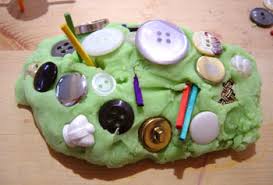
Playdough is a wonderful physical and creative activity for young children that fosters a variety of developments and skills in children. Playdough can easily be made in the kitchen. Most recipes include instructions to make playdough over the stove. An alternative choice is to use boiling water from the kettle. When making the playdough, it is a good idea to stir the ingredients quickly and knead right away to create the desired consistency. Ingredients can be added after if the playdough is too dry or too wet. The playdough mix should be kept in a plastic bag or closed container when it is not being used and depending on the air quality of a room, and the amount of hands that play with the dough, it should last for a least a week or longer.
This website is an awesome resource for playdough recipes: www.playdoughrecipe.com
Following are some variations and suggested items to put out with playdough in addition to the classic rolling pin and cookie cutters:
- koolaid package inside the playdough recipe will make it smell fruity and provides color
- a touch of tempera paint or food coloring while making the recipe
- sparkles inside the playdough
- vanilla or other spices
- place buttons out with the playdough
- candles along with baking sheet or cupcake liners
- little plastic animals
- plastic utensils
- container lids that have a raised image for making prints
- ice cube trays
- craft sticks, popsicle sticks
- googly eyes
(Always add lots of scoops and containers, or whatever seems appropriate with the suggested material.)
1. Water with washable dolls for bathing, add in empty shampoo bottles, and cloths
2. Scissors and a variety of paper to cut
3. Goop: water, food coloring and cornstarch (make sure there is water and soap nearby for cleaning up)
4. In the fall, add leaves, both real and paper/plastic and different nuts, such as chestnuts, and pinecones with rakes and containers for sorting (ie; cupcake containers)
5. Freeze water with food coloring in different sized containers and place in sensory table. Try placing different toys inside the water before freezing, or fill up a rubber glove with water and freeze
6. Die rice different colors for a rainbow effect: place rice in ziplock bags with a touch of rubbing alcohol and food coloring, shake and let dry on a cookie sheet
7. Little birthday bags, tissue paper, minature boxes and bows for wrapping
8. For the water table, add food coloring to the water, place tinfoil on the base and a variety of pebbles, add plastic fish and boats
9. In the winter, put snow in the table
10. Place in table a big bowl of soapy water, and small jars filled with water and a few drops of food coloring and eye droppers to use
11. In the sand, place little plastic animals, such as turtles or lizards, and yogurt containers upside down with cut out holes for the animals to peek their heads out of, then add some wood and plastic leaves
12. Place glass beads all throughout the sand and scoops that will release the sand through, then add some little bags with zippers to hold the discovered jewels
13. Find different colored straws and place in table with scissors
14. During springtime, fill the table up with easter grass, plastic easter eggs and little bunnies, ducks, chickens, etc.
15.Water, soap, dishrack, dishes and cloths
16. Add farm animals, a barn and some dishes that hold water or oatmeal for them to be fed.
17. Potted soil, pots, rakes, empty packaged seeds, plastic flowers
18. Add magnets and a variety of items to attract and those things that will not, such as paperclips versus wood.
19. At Halloween, fill the table up with black beans and orange dyed rice, then add plastic spiders and bats
20. Mix a variety of dried beans together for a sensory mix that can be used again and again
